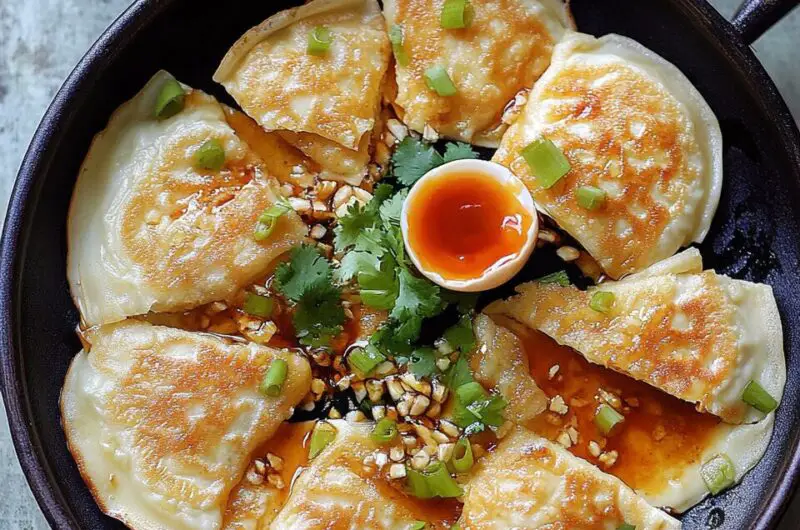The iconic Jian Bing is one of China’s most beloved street breakfasts, and for good reason. Its combination of textures crisp, soft, and chewy paired with layers of umami-rich sauces, fragrant herbs, and egg make it a standout morning treat. Whether grabbed from a busy Beijing street vendor or made fresh at home, it’s always satisfying and customizable. Perfect for those who want something beyond toast or cereal, Jian Bing delivers on both flavor and novelty. It’s easy to prepare once you master the thin crepe base and brings a delightful twist to breakfast or brunch menus. If you’re new to Chinese cooking, this is a great recipe to start your day the Asian way with bold tastes and a bit of crispy magic.
Full Recipe:
Ingredients:
-
1/2 cup mung bean flour (or all-purpose flour)
-
1/4 cup water (adjust for batter consistency)
-
2 large eggs
-
2 tablespoons chopped scallions
-
1 tablespoon cilantro, chopped
-
2 teaspoons chili sauce (adjust to taste)
-
1-2 sheets of crispy wonton wrapper or youtiao (fried dough sticks)
-
1 tablespoon sweet bean sauce or hoisin sauce
-
Oil for greasing the pan
-
Salt to taste
Directions:
-
In a bowl, mix mung bean flour with water until a thin batter forms. Add a pinch of salt and whisk until smooth.
-
Heat a non-stick skillet over medium heat and lightly grease with oil.
-
Pour a thin layer of batter into the pan, tilting it to spread evenly into a round crepe shape.
-
Crack one egg onto the crepe and use a spatula to spread it evenly.
-
Sprinkle scallions and cilantro over the egg. Let cook until the crepe edges begin to lift and the egg is mostly set.
-
Flip the crepe to briefly cook the other side for 10–15 seconds.
-
Flip it back again, then spread sweet bean sauce and chili sauce over the surface.
-
Place a crispy wonton sheet or piece of youtiao in the center.
-
Fold the crepe edges over the filling like an envelope or roll it up.
-
Serve hot, sliced in half or left whole.
Prep Time: 10 minutes | Cooking Time: 10 minutes | Total Time: 20 minutes
Kcal: 210 kcal | Servings: 2 servings
Jian Bing: The Quintessential Chinese Street Breakfast
If you’ve ever wandered the bustling morning streets of China, the scent of sizzling batter and aromatic sauces will lead you straight to one of the most beloved breakfast options in Chinese cuisine: Jian Bing. Often referred to as the “Chinese crepe,” Jian Bing is more than just a dish it’s a morning ritual, a cultural icon, and a perfect blend of flavor and texture that has stood the test of time.
In this in-depth look at Jian Bing, we’ll explore its origins, regional variations, cultural importance, and tips for preparing the perfect version at home. Whether you’re a curious foodie, a Chinese cuisine enthusiast, or simply someone who loves a good breakfast, this article will give you everything you need to fall in love with Jian Bing.
The Origins of Jian Bing
Jian Bing (煎饼) dates back nearly 2,000 years to the Eastern Han Dynasty. According to Chinese legend, the dish originated in Shandong Province. The story goes that a military strategist, Zhuge Liang, had to feed his army but lacked pots or pans. He instructed his soldiers to mix water with flour and cook it on a flat griddle thus, the humble beginnings of the now-famous crepe.
Traditionally, Jian Bing was made with millet or mung bean flour, but in modern times, wheat flour is often used for convenience and texture. What started as a clever battlefield solution evolved into one of China’s most iconic breakfast staples, found on nearly every street corner in cities like Beijing, Tianjin, and Shanghai.
What Makes Jian Bing Special?
Jian Bing is a masterclass in culinary contrast. The thin crepe is soft yet crispy, thanks to a short flip on the griddle. The egg is spread delicately across the surface to add richness. Fresh herbs like scallions and cilantro lend a bright, herbal kick. Sauces typically sweet bean paste and chili sauce provide depth and heat, while crispy additions like wonton crackers or baocui (a fried dough crisp) deliver the essential crunch.
Unlike sweet Western-style crepes, Jian Bing is unapologetically savory. Each bite brings together umami, heat, freshness, and crunch. It’s filling without being heavy, making it ideal as a quick meal that doesn’t sacrifice flavor or satisfaction.
Regional Variations
Although Jian Bing is ubiquitous across China, its preparation varies from region to region. Each city adds its own flair, using local ingredients or technique preferences:
-
Beijing Style: Known for its use of mung bean flour in the batter, this version often features a bold chili sauce and a strong soy-based paste.
-
Tianjin Style: A thicker crepe made with multiple layers, often including fermented tofu sauce and lettuce.
-
Shanghai Style: A more modern take, often using wheat flour, sometimes adding ham, cheese, or sausage for a fusion twist.
These variations reflect China’s rich culinary diversity and regional pride. No two Jian Bing vendors are exactly the same, and loyal customers will often walk extra blocks just to visit their favorite cart.
The Cultural Significance of Jian Bing
Jian Bing is more than just food it’s woven into the fabric of daily life in China. Early morning commuters grab it on the go; students stop by a favorite vendor before class; workers bond over Jian Bing breakfasts outside their offices. The dish represents nourishment, convenience, and tradition.
For many Chinese people, the memory of Jian Bing is deeply nostalgic. It’s a taste of home, often evoking thoughts of childhood and simplicity. In urban centers where modern life moves fast, the sizzling sound of batter hitting the griddle serves as a comforting constant.
Even as Chinese society evolves, Jian Bing has managed to keep its relevance, adapting to new tastes and global influences without losing its essence. Today, it’s not uncommon to find Jian Bing vendors offering vegetarian, vegan, or even gluten-free options, catering to younger generations and health-conscious eaters.
Jian Bing Goes Global
Over the last decade, Jian Bing has made its way onto the international culinary scene. Pop-up stalls, food trucks, and Chinese restaurants in cities like New York, London, and Sydney now serve up fresh, piping-hot crepes to curious locals and Chinese expats alike.
The global interest in Jian Bing reflects a broader fascination with street food and authentic ethnic cuisine. Its simple preparation and explosive flavor profile have made it a favorite among chefs who enjoy experimenting with cross-cultural combinations.
Some Western versions might incorporate non-traditional fillings like bacon, cheddar cheese, or avocado. While purists may balk at the idea, this flexibility shows the dish’s ability to transcend boundaries and adapt while still honoring its roots.
Pro Tips for Making Jian Bing at Home
Making Jian Bing at home is surprisingly accessible with a bit of practice and the right ingredients. Here are some expert tips to help you master the dish in your own kitchen:
1. Use the Right Batter Base
Mung bean flour offers a more authentic flavor and slightly elastic texture. However, all-purpose flour or a mix of flours can yield great results if mung bean flour is hard to find.
2. Control the Batter Thickness
A thin, even layer of batter ensures crisp edges and fast cooking. Pour sparingly and use a spatula or the back of a ladle to spread the batter quickly before it sets.
3. Don’t Skimp on the Egg
The egg should coat the crepe fully to add both structure and richness. Spread it out while the batter is still wet so that it bonds well.
4. Layer the Sauces Thoughtfully
Balance is key. Use a combination of hoisin or sweet bean sauce and chili sauce, adjusting quantities based on your heat preference. You want a touch of sweet, salty, and spicy in each bite.
5. Get Creative with Fillings
While crispy wonton wrappers or baocui are traditional, don’t be afraid to experiment with other crunchy ingredients like shredded lettuce, julienned cucumbers, or even crushed roasted peanuts.
Advertisement
Why Jian Bing is Perfect for Any Lifestyle
In today’s world of busy schedules and diverse diets, Jian Bing offers something for everyone. It’s:
-
Quick: Takes under 10 minutes to prepare with practice
-
Customizable: Can be made vegetarian, spicy, gluten-free, or even keto
-
Portable: Great for on-the-go meals or a packed lunch
-
Nutritious: With egg, herbs, and whole grain flours, it’s a balanced meal
Whether you’re looking to shake up your breakfast routine or host a Chinese-themed brunch, Jian Bing is a perfect conversation starter and crowd-pleaser.
Conclusion:
Jian Bing is more than just a breakfast dish it’s an experience. Its rich history, bold flavors, and cultural roots make it a staple worth preserving and sharing with the world. Easy to make, deeply satisfying, and endlessly adaptable, Jian Bing bridges the gap between tradition and innovation in the most delicious way possible.
For those looking to explore authentic Chinese cuisine, Jian Bing is an ideal entry point. It captures the essence of street food: fast, flavorful, and made with love. Try making it yourself, and you may just discover your new favorite way to start the day.








